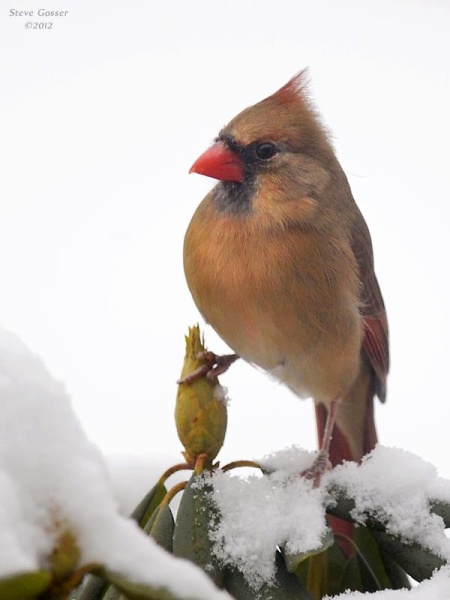
Every morning we awake to birdsong now. All the singers are male … right? Well, not really.
When I took a class on birdsong years ago I learned that female birds don’t sing. This information came from centuries of bird observations made in Europe and North America. Charles Darwin even used it to describe how song evolved in male birds to attract mates and compete for territory.
But in 2014 that “fact” was turned upside down. 71% of female songbirds do sing. It’s just that most of them are tropical species. No one had studied birdsong worldwide until a team lead by Karan Odom of University of Maryland, Baltimore County published their findings in Nature Communications in March 2014.
It’s true that almost all the singing birds in North America are male, but there are some exceptions.
Did you know that female northern cardinals (Cardinalis cardinalis) sing and they’re just as good at it as the males?
I was reminded of this last week when a female flew into a tree just over my head and sang a long sustained vibrato even faster than this:
Cardinal couples countersing to synchronize their pair bond. Yesterday in Schenley Park I saw a female sing a phrase several times, then her mate matched it.
So when you hear a cardinal singing, take the time to find the singer. It may be a lady!
p.s. Female rose-breasted grosbeaks (Pheucticus ludovicianus) and black-headed grosbeaks (Pheucticus melanocephalus) sing, too. They’re in the Cardinal Family.
(photo by Steve Gosser)
We had a male rose-breasted grosbeak at our feeders this morning. They have a lovely song. First time I have seen them this year.
I had two male rose-breasted grosbeaks at my feeder this a.m.
A first time in my yard, and possibly the first time I have ever seen one.
It’s not just singing, either — Sara and I saw a pair of cardinals at the DC zoo a few weeks back, and it really appeared that the female was making a display as well, flitting her tail back and forth while singing.
“But in 2014 that “fact” was turned upside down.” That’s weird, because in old books I have that are all in the public domain (pre-1920’s) many specie of wild birds male AND female, certain ones recommended for capturing & keeping at home for their song or sounds, these books are from around 1890s up to early 1900s. Some species they mention male or female, I can’t remember which specie exactly but I distinctly recall reading about it, because I made a note to myself how interesting that we as Americans kept wild birds as pets as a matter of course- one books is “Bird Hospital” by C Bascom, or “THE NATURAL HISTORY OF C A G E B I R D S :THEIR MANAGEMENT, HABITS, FOOD, DISEASES, TREATMENT,BREEDING, AND THE METHODS OF CATCHING THEM.” well, I cannot single out a specific sentence where female vs male “singers” is mentioned but I do know Ive read about it, and that it is not obscure. By the way, Ive nothing to do but read all day every day, and Ive at least 700 non-fiction antique books in digital and hard copy form, this is not the first nor will it be the last Ive been surprised to find a revelation that really should not be- I mean, “discoveries” that are not new, on account of the facts being published long before. I think the reason behind these “buried facts” is on account of all US libraries doing away with all books published pre-1983, so many valuable and instructive (if not obsolete!) titles have been lost to the public. Many of these books are animal books and bird books, but good luck finding any WORTH READING at any library today. Very hard to find now.